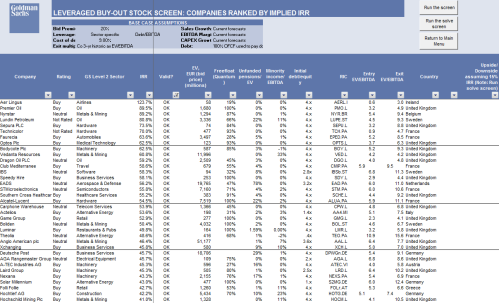Zero Hedge has an interesting article, How To Capitalize On The Upcoming Irrationally Exuberant LBO Bubble, about “the imminent tidal wave of going private deals.” Privatisations are one of the means by which undervalued small capitalization stocks can “close their value gap.” Said Daniel J. Donoghue, Michael R. Murphy and Mark Buckley in Wall Street’s Endangered Species:
Most useful for predominantly long equity investors like us, Zero Hedge also provides a copy of Goldman Sachs’ recently updated LBO screener (.xls), which looks like this (click to enlarge):

Says Zero Hedge:
Greenbackd
http://greenbackd.com/
Management buy-outs can provide shareholders with the attractive control premiums currently experienced in the private M&A market. Alternatively, strategic mergers can immediately deliver large cap multiples to the small cap shareholder.Bank of America’s Jeffrey Rosenberg sets the scene for what Zero Hedge calls “the LBO bubble v2:”
They’re back. The combination of the credit market resurgence and tight spreads, attractive equity valuations and ample private equity “dry powder” create the conditions for increasing the volumes of [leveraged buy-outs (LBOs)]. Whether deals will strike at the heart of the high grade market in the form of mega size transactions ($10b+) remains unclear, though the possibility clearly now exists. Unlike the most recent era, lower leverage and more prevalent change of control protections help to limit cram down losses. The IMS Health LBO illustrates the new LBO market dynamics – a $5.9B LBO funded with $3B in debt – where bank and mezzanine debt investors now augment the role of CLOs as key debt providers.CLOs are “collateralized loan obligations,” which Wikipedia says “are a form of securitization where payments from multiple middle sized and large business loans are pooled together and passed on to different classes of owners in various tranches. A CLO is a type of collateralized debt obligation:”
Each class of owner may receive larger payments in exchange for being the first in line to lose money if the businesses fail to repay the loans. The actual loans used are generally multi-million dollar loans known as syndicated loans, usually originally lent by a bank with the intention of the loans being immediately paid off by the collateralized loan obligation owners. The loans are usually “leveraged loans”, that is, loans to businesses which owe an above average amount of money for their kind of business, usually because a new business owner has borrowed funds against the business to purchase it (known as a “leveraged buyout”) or because the business has borrowed funds to buy another business.Rosenberg argues that the total pool of available LBO capital is ~$70B. Zero Hedge says, “Should CLOs indeed come back, look for this number to explode:”
Figure 1 below highlights our estimates of the maximum aggregate LBO volume supported by debt and equity fund raising capacity. These amounts represent only the limit on the size of LBO volumes, not our expectations of volumes in 2010. What is clear is that the return of the availability of senior debt financing is key to the ability to fund LBOs and this availability is supported by the new (relative to the earlier era) role of mezzanine debt in the “typical” LBO structure. According to these estimates of market capacity across senior, mezzanine and equity financing, expansion in senior debt financing capacity appears the constraint on the aggregate amount of LBO activity.

Note that this aggregate analysis does not describe the limits on mega size transactions – the $10B and above size transactions that garner greater attention and potential losses to cram down debt holders – as well as gains to public equity holders. That constraint remains the ability to absorb concentrated positions in a single fund. And as we describe more here, that constraint includes the new mezzanine debt financing capacity that contributes to today’s increasing amounts of debt funding capacity for LBOs.Rosenberg has a noteworthy approach to identifying LBO candidates:
After having argued for the potential for increasing volumes for LBO risk, the starting point for managing that risk is to identify names that are more likely candidates. Since definitively identifying LBO candidates is impossible, we take the other approach: exclude names in which an LBO is infeasible. By limiting the universe down to feasible LBO candidates, we create a starting point for designing hedging strategies. Moving beyond this step is both an art and a science. In the sample trading strategies below, we employ both quantitative approaches as well as bottoms up input from our team of fundamental analysts to identify this small sample of feasible (though not necessarily probable) LBO candidates.Click here to see Rosenberg’s LBO risk hedging strategies (via Zero Hedge).
Most useful for predominantly long equity investors like us, Zero Hedge also provides a copy of Goldman Sachs’ recently updated LBO screener (.xls), which looks like this (click to enlarge):

Says Zero Hedge:
The companies included represent the names most likely to be looked at actively by PE firms, and where a go private outcome would seem the highest. As such, buying the stock in a basket of the likeliest LBO candidates would be a relatively sure way to shotgun out a few quick LBO-type returns.This is similar, in essence, to the approach of Donoghue, Murphy and Buckley as described in Wall Street’s Endangered Species, a strategy that performed well over the last 10 years.
Greenbackd
http://greenbackd.com/